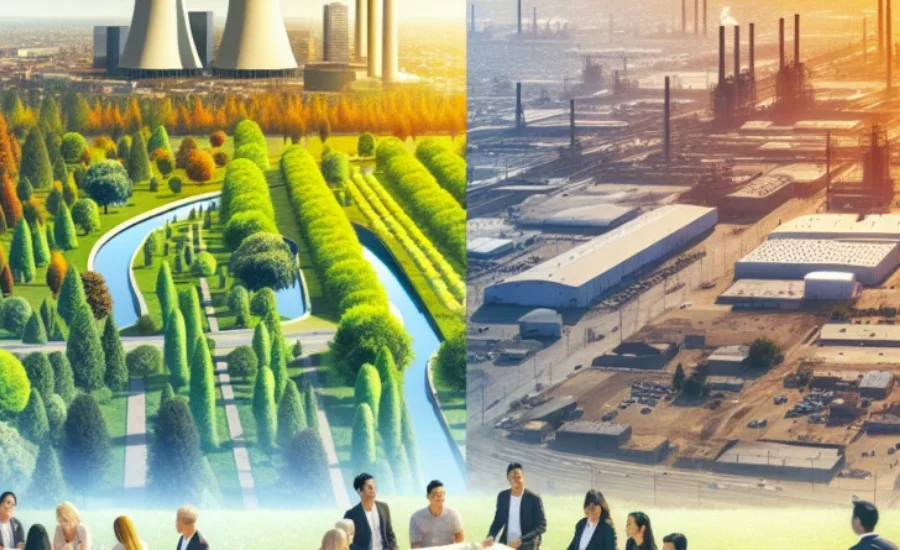Chart Comparing Pollution in Dorsten and Fresno; Dorsten is situated in Germany’s industrial Ruhr region, while Fresno is located in California’s Central Valley. These two cities may seem very different in terms of their geographical location and economy. Nevertheless, both are dealing with major environmental problems. Dorsten’s pollution is largely a result of its industrial history, particularly from manufacturing. On the other hand, Fresno’s pollution primarily stems from its widespread agricultural activities.
This juxtaposition sheds light on the management of crucial pollution concerns like air quality, water safety, and waste management in each city. Concentrating on these vital elements enables us to gain a deeper understanding of how Dorsten and Fresno are striving to safeguard their inhabitants’ health and boost their ecological sustainability.
We focus our analysis on the keyword “Dorsten vs Fresno pollution comparison chart” to delve into the impacts of pollution in these two regions. Our evaluation illuminates the current environmental conditions in both areas and offers insights into the steps being taken to fight pollution and foster long-term sustainability.
Pollution Dynamics in Dorsten vs. Fresno Pollution Comparison Chart: A Comprehensive Comparison

Geography plays a pivotal role in shaping the pollution dynamics of Dorsten and Fresno. Dorsten, located in Germany’s North Rhine-Westphalia region, has historically suffered from elevated pollution levels due to its proximity to major industrial centers. However, the implementation of stringent environmental regulations has helped alleviate much of this pollution.
Conversely, Fresno is located in California’s Central Valley, a geographical basin that ensnares pollutants. Consequently, the city deals with some of the poorest air quality in the United States. The pollution issues are further exacerbated by the city’s agricultural activities and extensive urban sprawl.
Water Pollution Challenges
Both cities face a significant problem with water pollution, though the causes and effects differ significantly. In Fresno, the majority of water concerns are due to agricultural runoff, introducing nitrates, pesticides, and other damaging chemicals into the water. The city’s old infrastructure exacerbates this issue, making it difficult to supply clean drinking water. Even with continuous efforts to enhance water systems and manage agricultural pollution, numerous Fresno communities continue to grapple with unsafe water.
Conversely, Dorsten profits from Germany’s stringent environmental policies, which mandate industries to treat wastewater before discharging it into rivers. The city’s community water treatment facilities utilize cutting-edge purification methods to guarantee clean drinking water. Furthermore, Dorsten advocates for water preservation through public consciousness drives, emphasizing the community’s dedication to protecting this essential resource.
Air Quality Comparison
Both Fresno and Dorsten grapple with considerable air quality issues, however, the extent of the problem varies. Fresno often finds itself among the most polluted cities in the U.S., mostly due to agricultural activities, vehicle emissions, and its valley location that ensnares pollutants. Regular pollutants such as nitrogen dioxide (NO2) and particulate matter (PM2.5) often result in smog in the region. Even with attempts to encourage the use of electric vehicles and implement stricter emission standards, Fresno still confronts serious air quality issues.
Air quality in Dorsten has seen a notable improvement over the years, primarily as a result of the reduction in heavy industry and the stringent emission regulations imposed by the European Union. Despite the ongoing contribution to pollution from vehicle emissions and industrial activities in surrounding regions, the city maintains relatively clean air, due to the persistent enforcement of environmental rules.
Waste Management Systems
Water pollution, despite varying causes and effects in different places, remains a significant issue. Agricultural runoff, primarily responsible for Fresno’s water issues, pollutes the water with harmful substances like nitrates and pesticides. The city’s obsolete infrastructure exacerbates the problem by hindering clean drinking water supply. Despite ongoing efforts to reduce agricultural pollution and improve water systems, many towns in Fresno still struggle with unsafe water.
Conversely, Dorsten benefits from the rigorous environmental laws in Germany that require businesses to purify their wastewater before releasing it into rivers. To ensure the provision of clean drinking water, the city’s public water treatment plants utilize advanced purification techniques. In addition, through public awareness campaigns, Dorsten promotes water conservation, thereby demonstrating the community’s commitment to safeguarding this vital resource.
Public Health Impact
The impact of pollution on public health is severe in both cities, with Fresno experiencing high incidences of health problems related to pollution, especially respiratory issues. The city records some of the highest childhood asthma rates in the US, and respiratory diseases are prevalent due to sustained exposure to substandard air quality. The health risks are more pronounced in Fresno’s vulnerable communities due to restricted healthcare access and are further exacerbated by these conditions.
Improvements in air and water quality have reduced many of the public health risks related to pollution in Dorsten. Nonetheless, the city continues to actively monitor pollution levels to guarantee ongoing public health protection.
Pollution Dynamics: A Comparison of Dorsten and Fresno
To comprehend the pollution issues confronting Dorsten and Fresno, it is necessary to examine their distinct geographical contexts. Dorsten, situated in Germany’s North Rhine-Westphalia region, has had a long battle with pollution due to its proximity to industrial centers. The city’s past heavy dependence on manufacturing played a significant role in causing environmental harm. Yet, stricter regulations and proactive environmental initiatives have recently driven improvements, resulting in a noticeable reduction in pollution levels.
Conversely, Fresno encounters a distinct yet equally demanding environmental predicament. Situated in the Central Valley of California, the city is naturally turned into a basin due to its geographical location, which results in the entrapment of pollutants and causes continuous air quality issues. The amalgamation of agricultural pursuits and urban expansion has placed Fresno amongst the most contaminated areas in the United States. This blend of environmental and manufacturing elements continues to create prominent air quality challenges for the region.
The intricate connection between geography, industrial development, and pollution control efforts is emphasized by both Dorsten and Fresno, as each city addresses its environmental challenges in unique ways.
Air Quality Comparison: Dorsten vs. Fresno Pollution Comparison Chart
Air quality in Dorsten has notably improved, primarily due to the strict emission standards imposed by the European Union. The reduction of heavy industries in the area has also significantly contributed to this positive change. Currently, despite the fact that vehicle emissions and industrial activities from surrounding regions continue to add to air pollution, Dorsten manages to maintain relatively clean air due to the rigorous enforcement of environmental regulations.
On the other hand, Fresno struggles with serious air quality problems and is regularly listed among the most polluted cities in the U.S. The city’s issues are due to a combination of elements such as its agricultural methods, high car emissions, and the geographical drawback of being situated in a valley that captures pollutants. Dangerous substances like nitrogen dioxide (NO2) and particulate matter (PM2.5) frequently contribute to the area’s smog. Despite attempts to encourage cleaner options like electric vehicles and tighter emission regulations, Fresno still grapples with substantial air pollution challenges.
Public Health Impacts of Pollution in Dorsten vs. Fresno Pollution Comparison Chart

It is evident from the comparison between Dorsten and Fresno that pollution significantly and directly impacts public health.
The population of Dorsten has been experiencing improved health outcomes due to the combination of cleaner air and water. The incidence of respiratory conditions like asthma and chronic bronchitis is notably lower compared to numerous other industrialized cities. This beneficial health situation can be primarily attributed to the implementation of stringent environmental regulations and effective public health measures, which prioritize the wellness of the community.
On the flip side, Fresno grapples with significant public health issues directly linked to its elevated pollution levels. The city ranks among the highest in the nation for childhood asthma rates, and the widespread prevalence of respiratory diseases can be attributed to long-term exposure to poor air quality. Most affected are vulnerable groups who often lack access to quality healthcare services. Therefore, for Fresno’s residents, tackling these pressing public health matters remains a top priority.
Air Quality Challenges in Fresno
A combination of environmental factors and human activities significantly impacts the air quality in Fresno, leading to serious pollution issues. The region’s large-scale agricultural industry, especially in the San Joaquin Valley, is one of the primary contributors. Industrial farming and the widespread use of pesticides in this area discharge pollutants into the air, thereby exacerbating the pollution levels.
Furthermore, Fresno’s closeness to major roads contributes to constant vehicle emissions, especially during high traffic periods. This continuous output of car pollutants exacerbates the area’s air quality issues. Seasonal wildfires also intensify the problem, mainly during the dry summer and fall seasons when smoke and particulate matter descend into the valley. During these times, Fresno’s Air Quality Index (AQI) can reach hazardous levels, presenting severe health threats to its residents.
Key Pollution Metrics for Comparing Dorsten and Fresno
In order to make a precise comparison of pollution levels in Dorsten and Fresno, it’s necessary to utilize uniform environmental metrics. These indicators offer a transparent and quantifiable method to evaluate the air quality and related health risks in both cities. The most important metrics consist of:
- PM2.5 and PM10: These represent fine particulate matter (PM2.5) and larger particles (PM10). PM2.5, in particular, can penetrate deep into the lungs and enter the bloodstream, posing significant health risks.
- Nitrogen Dioxide (NO2): Commonly emitted by vehicles and industrial activities, NO2 is known to exacerbate respiratory issues.
- Ozone (O3): Ground-level ozone forms through chemical reactions between pollutants and can aggravate respiratory conditions.
- Carbon Dioxide (CO2): While not directly harmful to health, CO2 is a major contributor to climate change and has wide-reaching environmental impacts.
Comparing Dorsten and Fresno, these key metrics will offer a thorough comprehension of pollution levels.
Dorsten vs. Fresno Pollution Comparison Chart: Pollution Comparison
By comparing pollution levels in Dorsten, Germany, and Fresno, California, through key indicators like PM2.5, NO2, and ozone levels, we see significant differences in air quality. This analysis allows us to gain a deeper understanding of the environmental issues both cities are grappling with.
Here is a summary of the main pollution data for Dorsten and Fresno:
| Pollution Indicator | Dorsten, Germany | Fresno, California |
|---|---|---|
| PM2.5 (µg/m³) | 12 | 22 |
| PM10 (µg/m³) | 20 | 34 |
| NO2 (µg/m³) | 25 | 17 |
| Ozone (µg/m³) | 40 | 65 |
| Air Quality Index (AQI) | Moderate (55 AQI) | Unhealthy (120 AQI) |
| Water Pollution Index | Low | High |
| Noise Pollution Index | Moderate | High |
Air Quality Index (AQI) Comparison
The Air Quality Index (AQI) serves as a critical indicator of overall air quality, where higher values point to more serious levels of pollution. Typically, Dorsten registers an AQI about 55, which falls under the “moderate” category. This implies that while the air is generally safe, it might sometimes present hazards to sensitive groups.
On the other hand, Fresno frequently records AQI levels of 120 or more, predominantly in the summer months. This situates it in the “unhealthy” classification, indicating significant health hazards, especially for people with pre-existing respiratory issues.
PM2.5 Levels: A Significant Concern for Fresno
Fine particulate matter, also known as PM2.5, is a highly damaging form of air pollution that can infiltrate the lungs deeply and lead to severe health problems. The average PM2.5 concentration in Fresno is 22 µg/m³, which is substantially more than the 12 µg/m³ in Dorsten. The higher levels in Fresno are due to its heavy agricultural activities, vehicular pollution, and regular wildfires. Although Dorsten’s PM2.5 levels are lower, they tend to rise during winter because of the increased usage of wood-burning stoves and traffic. However, strict regulations in the city help limit industrial emissions, providing a benefit to its air quality.
NO2 and Ozone Levels: Contrasting Challenges
Both nitrogen dioxide (NO2) and ozone (O3) are significant pollutants that can impact health adversely. Dorsten has a higher NO2 concentration (25 µg/m³) than Fresno (17 µg/m³), primarily due to diesel vehicle emissions. Sustained exposure to increased levels of NO2 can result in severe respiratory problems.
On the other hand, Fresno has a more severe problem with ozone pollution, as it records average levels of 65 µg/m³, which is significantly higher than Dorsten’s 40 µg/m³. The issue of ozone pollution in Fresno is made worse by the area’s farming activities and its geographical features that tend to trap pollutants.
The environmental challenges Dorsten and Fresno face are underscored in this pollution comparison. Although Dorsten handles pollution through rigorous rules and sophisticated technologies, Fresno’s struggle with agricultural runoff, vehicle emissions, and wildfires makes enhancing air quality a more intricate issue.
Pollution Reduction Efforts in Dorsten and Fresno

Both Dorsten and Fresno hold substantial promise in spearheading pollution reduction, each boasting distinctive opportunities for advancement. Dorsten is already reaping the rewards of purer air than many industrial cities and could bolster its environmental efforts by amplifying investments in electric vehicles and broadening its utilization of renewable energy sources. These measures would help in mitigating emissions from transportation and energy sectors, thus leading to even superior air quality.
Conversely, Fresno grapples with more pronounced pollution issues, though it can improve by enforcing more rigorous agricultural rules. The city’s dependence on industrial agriculture, along with the use of pesticides, substantially contributes to its pollution levels. Concentrating on eco-friendly farming methods and embracing more environmentally friendly technologies could help Fresno drastically minimize both air and water pollution.
Sharing best practices and learning from each other’s experiences in pollution control can also be beneficial for both cities. By collaborating, Dorsten and Fresno can create innovative solutions to enhance environmental health, thereby guaranteeing cleaner, more sustainable habitats for future generations.
Final Words
To sum up, the juxtaposition of Dorsten and Fresno underscores the unique challenges and opportunities they both encounter in the sphere of pollution. Dorsten enjoys the advantages of stringent laws and effective water management, while Fresno grapples with severe air and water pollution issues, predominantly stemming from agricultural runoff and outdated infrastructure. By investing in sustainable practices, sharing effective strategies, and prioritizing community health, both cities can pave the way towards a cleaner, healthier future. Pollution reduction not only enhances the quality of life for current residents, but also ensures a sustainable environment for future generations. Dorsten and Fresno have the capacity to establish themselves as pioneers in pollution reduction through collective initiatives, demonstrating that collaborative efforts can yield substantial environmental benefits.
For more information and updates join us on Alevemente.
Dorsten vs. Fresno Pollution Comparison Chart: Analyzing Environmental Challenges – Alevemente




